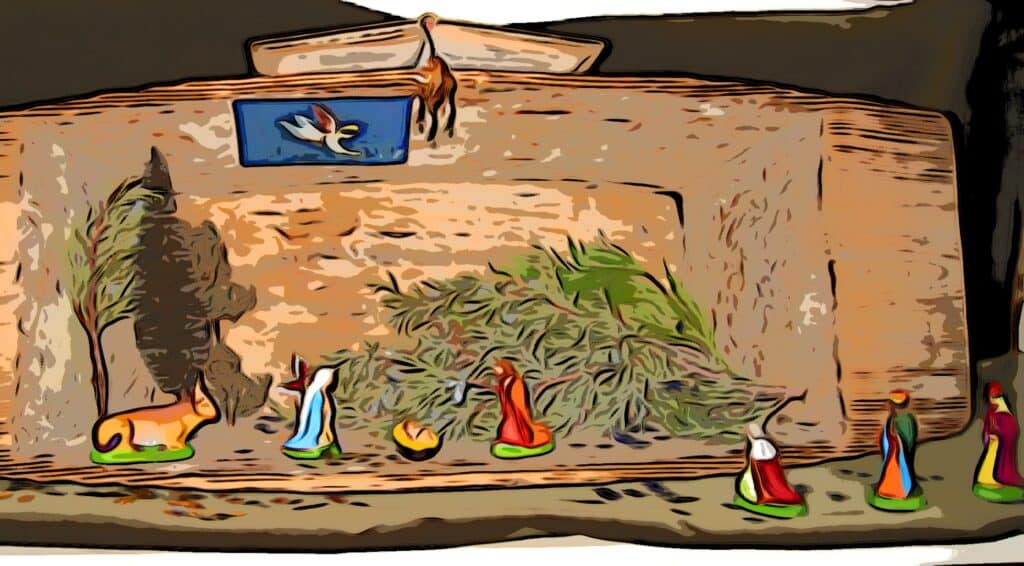
by Joanna Clapps Herman
I am strolling on the streets of Aix en Provence in a brilliant penetrating Mediterranean summer afternoon. The dry heat carries me up a gently sloping street lined with small shops and stalls: I’m on my way to meet up with my boyfriend, Jon, in a café. In the good heat, on this lively street and in the pleasure of being where I am, I seek now a bit of shade from the overhanging awnings (or was it just the shade of the buildings), now more sun.
The street is filled with tourists coming back out into the afternoon after cooling naps behind closed wood shutters in small hotels. We wear espadrilles, colorful sundresses. We carry simple straw bags we’ve purchased only the day before on similar streets. Tables of wares line the narrow sidewalks. Jon and I arrived in Aix yesterday.
I’m feeling this sun, carrying in me still the Italian sun where we’d just been fare un gira deciding whether I’ll have a citron pressė, which I can pronounce almost correctly. Not zucca di limonata. Or maybe a caffé freddo.
Three boisterous young guys, slender arms draped over each other’s shoulders, brush past me laughing, “Deficente,” one shouts in Italian. My new straw bag swings into the table next to me. I may be walking too slowly for even this Mediterranean afternoon. I stop my bag from swinging too wide. It has only narrowly missed knocking things over.
I look down to see what I am protecting and I find there a river of colors: reds, yellows, blues, greens, spreading out in front of me on these tables: primary colors, earth colors, water colors. Miniature figures: people, animals, rustic houses, barns, animals fill the tables. I stop, hesitate, start to move forward and pause again.
There is an exploding display of nativity figures spread out in front of me. Hundreds of them. Thousands of them.
A woman in a yellow dress designed with an immense sunflower, petals as long as an arm, jostles past me. One white petal fills the side of her shirt. Arms linked with her boyfriend. I am in the way. Unable to move out of the way.
I look up and I see in that there is a row of these shops. A world of nativity. Jon will have to wait.
The three young Italian guys are running across the street now. The woman in the bright yellow sundress with large white petals who has stopped at the corner turns to her companion, leans into him. She becomes even more alive as her skirt swings in slow motion around her legs. Her companion’s laugh, drops into the afternoon, in timing to the swish of his girl’s dress.
The Mediterranean heat becomes translucent. I lean over to take in the abundance of what is laid out in front of me. I’m slipping through a knot in time or ( I’m slipping through a sliver in time) which? inundated with memories of my sister, Lucia, and I setting up our nativity scene under the Christmas tree. The sensations of colors and details in front of me are wending their way back to my Italian family. Disbelief accompanies me too. These both are and are not the nativity figures of my childhood, wildly varying and differing from our simple basic set. Along side the standard holy figures, Mary, Joseph, baby Jesus, the three kings, camels, sheep, shepherds, is great variation of people at their old world occupations: the hunter, the egg woman, the woodcutter, the water woman, the baker. I put my bag down between my feet, pressing the bag tightly between my legs.
The heat is on my back. I bend over this large table to study these treasures. Gingerly I pick up a small peasant man who fits perfectly into the palm of my hand. He has a red jacket with small folds of the fabric showing work and wear, His blue pants and black wide hat. Small baskets filled with eggs. Next to him is a female holding a small child’s hand with a shawl over her head.
These figures look like the diminutive immigrant Italians I know intimately: my grandparents, their paesani, my people, some I knew from Waterbury and some from Tolve Avigliano our hometowns in southern Italy. There are small buildings that look very much like my families homes in Tolve and Avigliano, made of stone and stucco, red tiled roofs with arched doorways. Wood wheel barrels sit in front of these buildings filled with the same kind of hay as those from our masseri’.
Many of these figures are of people who work with their hands, people who make things with their hands, men and women who work with animals and the land, who hold rabbits upside down, carry large hams on their shoulders, baskets of cheese and eggs. Figures who wear rumpled and patched work clothes. There are also figures of priests, barbers, even gentlemen and gentlewomen too.
An extravagant display of figures in holy and unholy. The woodman carries a bundle of branches high on his shoulder. Not sacred and profane, but sacred and vernacular. An old world of meaning. A nativity omphalos.
This table, this display opens a portal back to my childhood in Waterbury, back to my ancestors in Italy. I understand again the sacrilege of our having allowed our precious manger figures to been lost to us when we hadn’t been paying attention (having gone off to our newly more important worldly lives). Now it becomes too achingly clear to me.
Very beautiful, Joanna. Felt like I was there on that street with you, feeling the intense heat on my back
Love
Judy